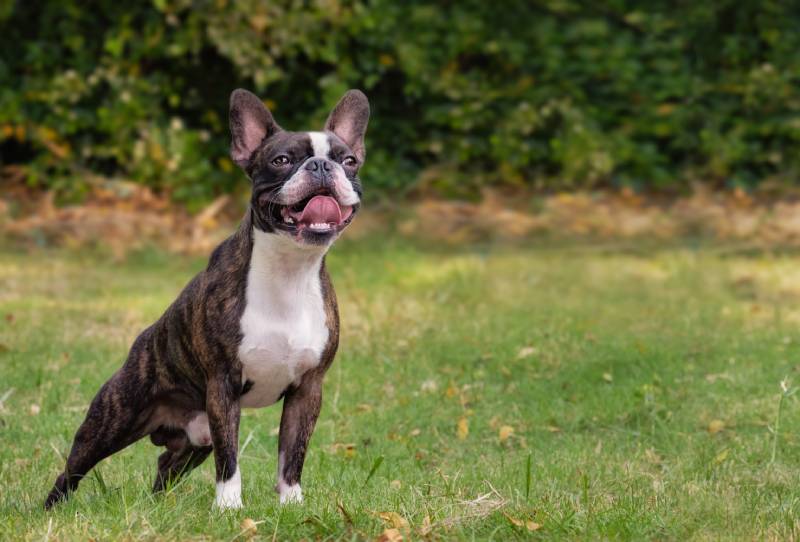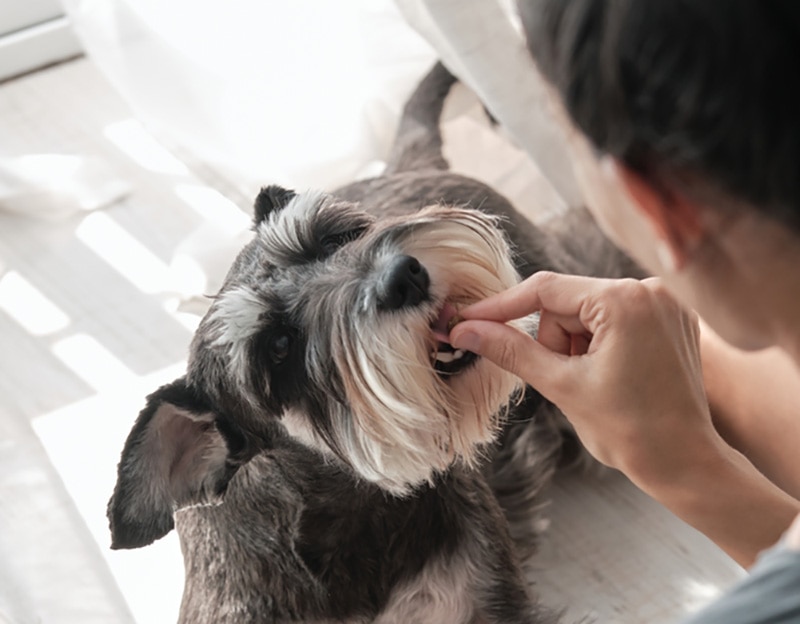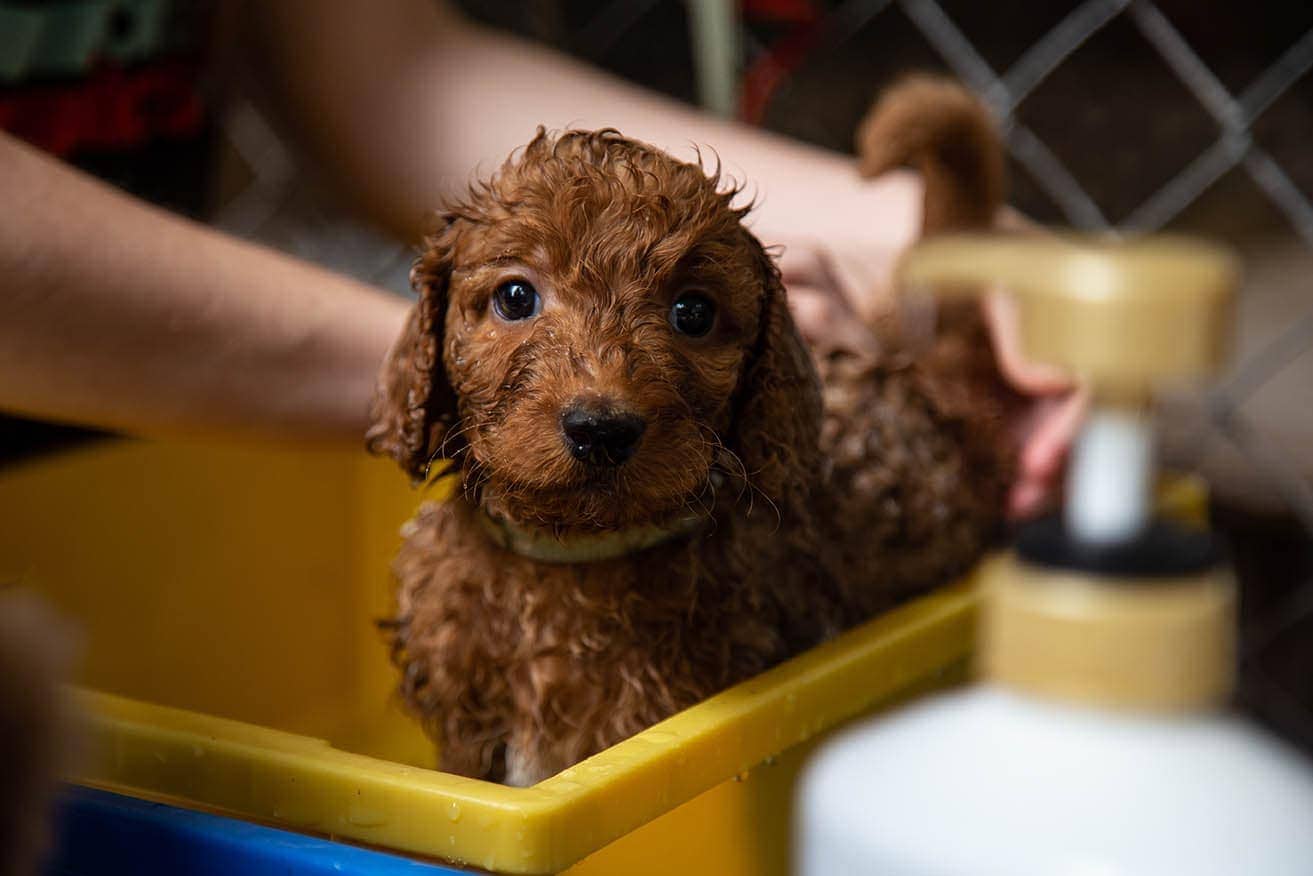Golden Pyrenees (Great Pyrenees & Golden Retriever Mix): Pictures, Info, & Facts

Updated on
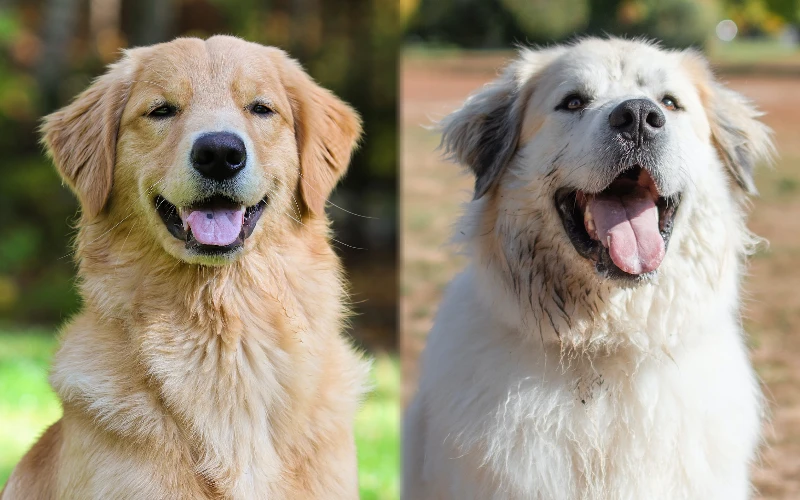
The Golden Pyrenees comes from two working breeds that couldn’t be more different despite their somewhat similar looks. Combining the Golden Retriever’s playfulness and the Great Pyrenees’s patience, these dogs offer the best of both worlds for owners looking for an incredible family dog. Find out all these loyal and loving dogs have to offer as we explore the many interesting facts surrounding the Golden Pyrenees.
Breed Overview
| Height: | 25–32 inches |
| Weight: | 70–100 pounds |
| Lifespan: | 10–12 years |
| Colors: | Golden, white |
| Suitable for: | Active individuals and families, those needing a guard dog |
| Temperament: | Devoted, intelligent, biddable yet independent, aloof with strangers |
The Golden Pyrenees is a large yet gentle dog with a delightful temperament suitable for numerous living situations. The Golden Retriever is America’s third most popular purebred. The Golden Retriever originated in Scotland in the early 1800s and was a valued and versatile hunting dog. They’re trainable, obedient, playful, and upbeat, and they’re well-known for their family-friendliness and deferential nature.
While the Golden Retriever arose as a close aide and companion to gentleman hunters, the centuries-old Great Pyrenees originally lived a solitary life. Also called the Pyrenean Mountain Dog in certain countries, the breed originated in the Pyrenees Mountains, assisting peasant shepherds as loyal yet independent guardians for the home and flock. They have become beloved family dogs and watchdogs. Like the Golden Retriever, their gentle nature makes them excellent for service work.
Golden Pyrenees Characteristics
Golden Pyrenees Puppies
https://www.instagram.com/p/CmzdLF_pxdA/?utm_source=ig_web_copy_link&igshid=MzRlODBiNWFlZA==
With lovable faces juxtaposed against their fluffy, huggable coats, finding a more adorable puppy than the Golden Pyrenees is challenging. Since they’re energetic and willing to explore and bond, their early months are a crucial time for training and socializing, especially to temper any mouthiness from the Golden Retriever and aloofness from the Pyrenees side.
During this time, your dog will learn to understand vital boundaries and behaviors, particularly around strangers at home and in public. With designer dogs like the Great Pyrenees (and any dog, for that matter), vetting breeders is crucial to ensure your dog’s pedigree is legitimate and they aren’t hiding any health defects.
Great Pyrenees are not prevalent or in-demand hybrids, so reputable breeders are few and far between. The website goldenpyrenees.com is an excellent starting point for finding available Golden Pyrenees puppies.
You can also explore pet adoption websites such as Petfinder or Adopt a Pet, though these dogs are more challenging to verify genetically and are often more mature. The Great Pyrenees Rescue Society also features many pets for adoption, including Golden Retriever hybrids, giving prospective pet parents the dog they want while helping an animal in need.
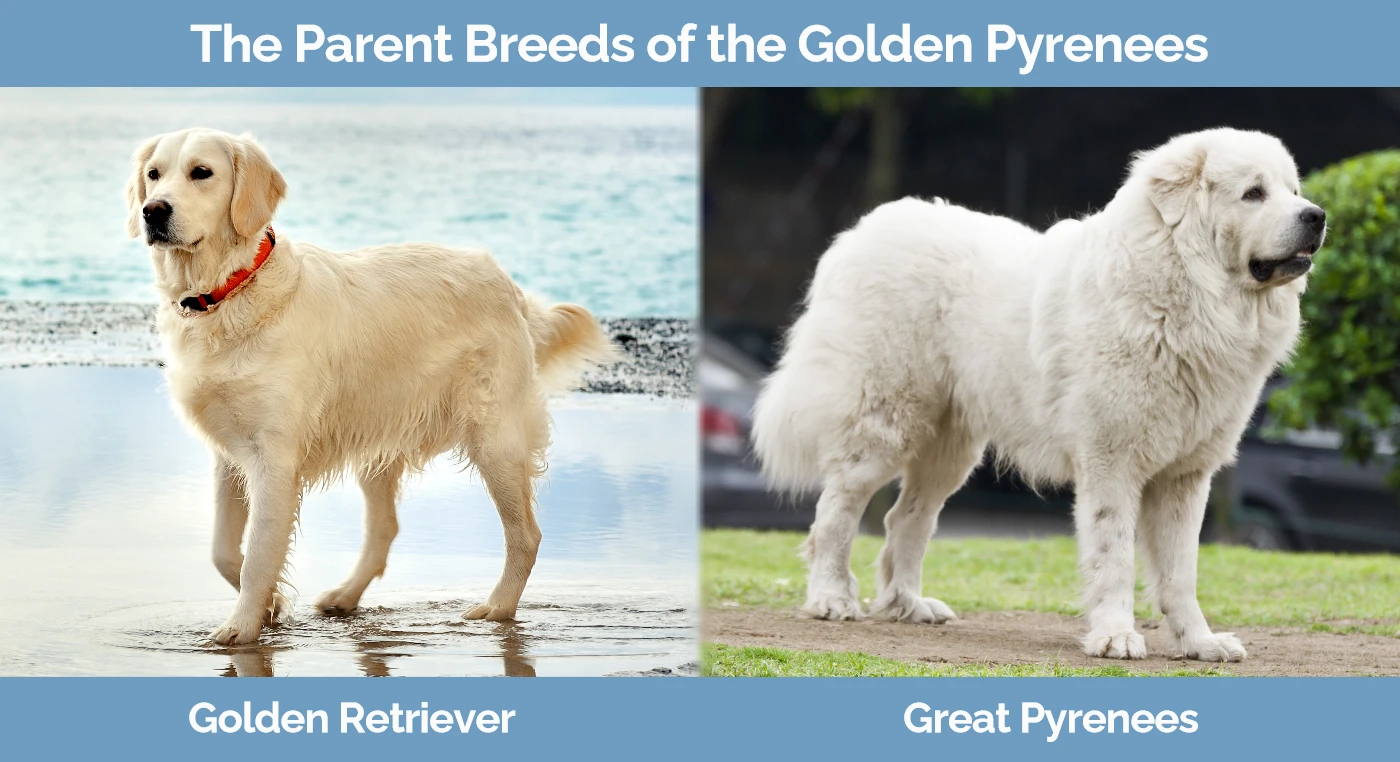
Temperament & Intelligence of the Golden Pyrenees
The Golden Pyrenees has an exceptional temperament with people and other animals. They’re laid-back, intelligent, and trainable, though their dominant, independent personalities can be problematic when they don’t have a confident leader. Socialization is critical if your mix receives more of the Pyr’s temperament to overcome aloofness with strangers.
Great Pyrenees live to protect, so training their hybrid offspring to be comfortable with people in their territory should be a primary focus. While the Pyr’s size and relatively low-activity routine make their Golden Retriever mixes more manageable for less active families, the Retriever’s influence gives them a high social ceiling and eagerness to please that first-time owners and long-time dog lovers alike can appreciate.
Golden Retrievers are outgoing and affectionate. They love playing with family and meeting new people and pets. Their obedience and sociability make them one of the top service and therapy dog breeds.
Are These Dogs Good for Families? 👪
Hybrids can inherit unpredictable temperaments and traits, but Golden Pyrenees may be the perfect family dog. While the dog’s size can make some parents uneasy pairing them with small children, their gentle, considerate, and protective approach to family members is reassuring.
On their side, children stand little chance of hurting the dog. In any event, the Golden Pyrenees’s patient attitude will keep them from lashing out over occasional mishandling and awkward petting.
Does This Breed Get Along With Other Pets?
If your Golden Pyrenees adopts the Golden Retriever’s social adaptability, trainability, and low–moderate prey drive, you’ll likely have no problem bringing other pets, big or small, into the house.
The Pyrenees’s influence can cause natural conflict due to their solitary lives and dominant personality, especially between same-sex dogs. Like any dog, the most successful pairings come with early introductions and consistent socialization from a young age.
Things to Know When Owning a Golden Pyrenees:
Food & Diet Requirements 🦴
Weighing up to 100 pounds, Golden Pyrenees eat a lot, though the Pyr’s metabolism may be slower than that of similar-sized dogs. As a result, they may require less food than you might expect. Generally, they need about 3–4 cups of food daily.
Golden Pyrenees puppies need smaller, more frequent meals than adults. Mature dogs may also benefit from multiple meals to prevent the risk of bloat. Feeding high-quality, large-breed dog food utilizing natural ingredients is ideal.
As they may need a specific routine to avoid obesity and other health issues, you may want to work with your vet to establish a sensible feeding plan and closely monitor your dog’s weight for unnatural gains.
Exercise 🐕
Golden Retrievers add energy to the Golden Pyrenees, making them need more activity than the typical Great Pyrenees. Pyrs are known for moderate energy levels that you can easily satisfy with a few walks around the neighborhood.
With the Golden Retriever’s genetics, they may need more time or activity through playtime in a backyard or at a dog park.
Training 🎾
Hope for a Retriever but plan for a Pyrenees. If your hybrid is more like the latter, training is often a breeze and something even a first-time dog owner can execute successfully. But when they have a Pyrenees personality, training requires poise, patience, and, in some cases, expertise.
Though intelligent, Pyrenees are generally strong-willed and independently driven, giving them selective deafness and a low tolerance for standard training. Shorter sessions early and often will keep your dog engaged and open to learning. More importantly, establishing positive yet firm control in a relationship with these dominant dogs is essential.
Grooming ✂️
The Golden Pyrenees’s long, plush double coat sheds vigorously twice annually and continuously releases fur year-round. Far from a hypoallergenic breed, they’ll add miles to your brushes and vacuum quickly. Brushing twice weekly will release dead hair, but you’ll have to make it a daily affair in the spring and fall when they blow their coat.
Bathing will depend on whose coat they inherit. Golden Retrievers can develop a bit of a doggy odor, while Great Pyrenees’ coats tend to stay dirt- and tangle-free. Hopefully, yours will inherit more of the Pyr’s coat, giving you relief from frequent bathing.
Health and Conditions 🏥
Although many believe hybridizations reduce the risk of recessive genetic diseases, Golden Pyrenees can be susceptible to many issues common to Great Pyrenees and Golden Retrievers, such as bloat, cataracts, and hip dysplasia.
Meanwhile, they aren’t completely immune to the common health issues unique to either breed, such as hypothyroidism in Golden Retrievers and neuronal degeneration in Great Pyrenees. Asking for adequate health screenings is essential when buying from a breeder.
- Eye disorders (e.g., cataracts, entropion)
- Bloat (gastric dilatation-volvulus)
- Hip dysplasia
- Patellar luxation
Male vs Female
Male Golden Pyrenees are a few inches larger than females and weigh roughly 10–15 pounds more. Anecdotally, many owners have noticed differences in temperament between the sexes. Males seem closer to family and more eager to please, while females appear more reserved and independent.
Spaying and neutering will reduce temperament issues and make your dog less aggressive. Notably, the quality of the environment will impact a dog’s personality more than their sex.
3 Little-Known Facts About The Golden Pyrenees
1. They May Be Closely Related to Wolves
Many believe the Great Pyrenees is unique as a lupomossoloid dog. Unlike the ancient molossoid dogs from Asia that gave us the modern-day Mastiff and its relatives, the Great Pyrenees may descend from an extinct line of Asian wolves.
Given this potential connection, the Pyr’s independent nature and desire to establish dominance among peers becomes much less surprising.
2. They Don’t Need Haircuts
The massive fluffy coat may seem high maintenance, but trips to the groomer may not be a requirement. As with many double-coated heavy shedders, Golden Pyrenees make up for the heavy brushing demands by needing little in the way of haircuts.
At most, they might need trimming around the ears, eyes, and paws. Otherwise, the coat will maintain its length without any intervention. Cutting the coat could even be dangerous for your dog, as it provides the dual benefits of keeping your pet warm or cool as needed.
3. They Might Bark a Lot
Their size and energy levels aren’t the only reasons Golden Pyrenees make less-than-ideal apartment dogs. Being a watchdog that stays alert to strangers and unexpected occurrences, the Great Pyrenees can be an avid barker.
While the friendly Golden Retriever rarely vocalizes when there’s movement at the door, you can expect their crossbreed to be more protective.
Final Thoughts
Single seniors, young couples with kids, and everyone in between can benefit from a Golden Pyrenees. Since they’re gentle, loving, and bright, they’re a joy to train and socialize and are more than willing to please their owners when they have adequate attention from a capable, firm leader.
If you can give them daily walks and enrichment, there will be nothing left but to enjoy the loving, peaceful presence they bring to the home.
Related Article:
Featured Photo Credit: Left – Shayna Douglas, Unsplash | Right – Ryan Leeper, Pexels



